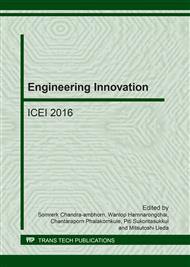[1]
Z. He, W. X. Que, Electrochemical behavior & Photocatalytic performance of nitrogen-doped TiO2 nanotubes arrays powders prepared by combining anodization with solve thermal process, Ceramics International. 39. (2013) 5545-5552.
DOI: 10.1016/j.ceramint.2012.12.068
Google Scholar
[2]
M. M. Mohamad, Y. Ghayeb, Fabrication characterization and photoelectrochemical behavior of Fe-TiO2 nanotubes composite photoanodes for solar water splitting, Journal of Electroanalytical Chemistry. 751 (2015) 43-48.
DOI: 10.1016/j.jelechem.2015.05.035
Google Scholar
[3]
Y. Zhang, W. Fu, H. Yang, Q. Qi, Y. Zeng, G. Zou, Synthesis and characterization of TiO2 nanotubes for humidity sensing, Applied Surface Science. 254 (2008) 5545-5547.
DOI: 10.1016/j.apsusc.2008.02.106
Google Scholar
[4]
H. Park, W. R. Kim, W. Y. Choi, Fabrication of dye-sensitized solar cells by transplanting highly ordered TiO2 nanotube arrays, Solar Energy Materials & Solar Cells. 95 (2011) 184-189.
DOI: 10.1016/j.solmat.2010.02.017
Google Scholar
[5]
L. Qin, Q. Chen, Effect of Anodization Parameters on Morphology and Photocatalysis Properties of TiO2 nanotube arrays, Journal of Materials Science & Technology. 31 (2015) 1059-1064.
DOI: 10.1016/j.jmst.2015.07.012
Google Scholar
[6]
S. Wantawee, P. Krongkitsiri, S. Tippawan, B. Samran, U. Tipparach, Synthesis and structure of titania nanotube for hydrogen generation, Advanced Material Research. 741 (2013) 84-89.
DOI: 10.4028/www.scientific.net/amr.741.84
Google Scholar
[7]
E. N. Timah, R. Vongwatthaporn, N. Kodtharinand U. Tipparach, Photocatalytic Performance of Fe-doped TiO2 Nanotubes in DSSCs, Journal of Materials and Applied Energy. 3 (2014) 5-8.
Google Scholar
[8]
K. N. Amponsah, V. Hornebecq, T. Djenizian, Properties of Sn-doped TiO2 nanotubes fabricated by anodization of co-sputtered Ti-Sn thin films, Electrochimica Acta. 62 (2012) 192-198.
DOI: 10.1016/j.electacta.2011.12.021
Google Scholar
[9]
J. Geng, D. Yang, J. Zhu, D. Chen, Z. Jiang, Nitrogen-doped TiO2 nanotubes with enhanced photocatalytic activity synthesized by a facile wet chemistry method, Materials Research Bulletin. 44 (2009) 146-150.
DOI: 10.1016/j.materresbull.2008.03.010
Google Scholar
[10]
V. Zwilling, M. Aucouturier, E. Darque-Ceretti, Anodic oxidation of titanium and TA6V alloy in chromic media an electrochemical approach, Electrochim Acta. 45 (1999) 921-929.
DOI: 10.1016/s0013-4686(99)00283-2
Google Scholar
[11]
M. Fatemeh, M. Mahmood, Double-layer TiO2 nanotube arrays by two-step anodization: Used in back and front-side illuminated dye-sensitized solar cells, Materials Science in Semiconductor Processing. 39 (2015) 255-264.
DOI: 10.1016/j.mssp.2015.04.048
Google Scholar
[12]
H. Song, J. Shang, C. Suo, Fabrication of TiO2 nanotube arrays by Rectified Alternating Current Anodization, Journal of Materials Science & Technology. 31(1) (2015) 23-29.
DOI: 10.1016/j.jmst.2014.07.005
Google Scholar
[13]
K. Siuzdak, M. Szkoda, A. L. Oleksiak, J. Karczewski, J. Ryl, Thin layer of ordered boron-doped TiO2 nanotubes fabricated in a novel type of electrolyte and characterized by remarkably improved photoactivity, Applied Surface Science. 357 (2015).
DOI: 10.1016/j.apsusc.2015.09.130
Google Scholar
[14]
M. M. Momeni, Y. Ghayeb, Z. Ghonchegi, Fabrication and characterization of copper doped TiO2 nanotube arrays by in situ electrochemical method as efficient visible-light composite photocatalyst, Ceremics International. 41 (2015) 8735-8741.
DOI: 10.1016/j.ceramint.2015.03.094
Google Scholar
[15]
X. Fan, J. Wan, E. Liu, Y. Hu, H. Li, X. Hu, J. Fan, High-efficiency photoelectrocatalytic hydrogen generation enabled by Ag deposited and Ce doped TiO2 nanotube arrays, Ceremics International. 41(2015) 5107-5116.
DOI: 10.1016/j.ceramint.2014.12.083
Google Scholar
[16]
L. Sun, J. Li, C.L. Wang, S.F. Li, H.B. Chen, C.J. Lin, An electrochemical strategy of doping Fe3+ into TiO2 nanotube array films for enhancement in photocatalytic activity, Solar Energy Materials & Solar Cells. 93 (2009) 1875–1880.
DOI: 10.1016/j.solmat.2009.07.001
Google Scholar
[17]
R. Camposeco, S. Castillo, J. Navarrete, N. Nava, Boosted surface acidity in TiO2 and TiO2-Al2O3 nanotubes as catalytic supports, Applied Surface Science. 356 (2015) 115-123.
DOI: 10.1016/j.apsusc.2015.08.026
Google Scholar
[18]
J.Y. Lin, Y.T. Chou, Effects of rapid thermal annealing on the structural properties of TiO2 nanotubes, Applied Surface Science. 258 (2011) 530-534.
DOI: 10.1016/j.apsusc.2011.08.073
Google Scholar
[19]
X. Chen, M. Schriver, T. Suen, S. S. Mao, Fabrication of 10 nm diameter TiO2 nanotube arrays by titanium anodization, Thin Solid Film. 515 (2007) 8511-8514.
DOI: 10.1016/j.tsf.2007.03.110
Google Scholar


